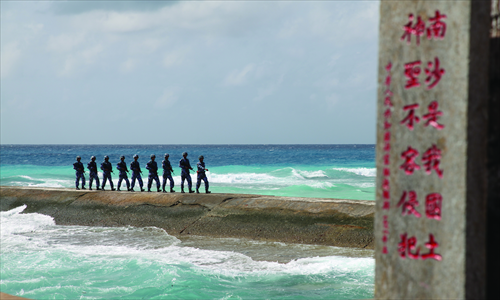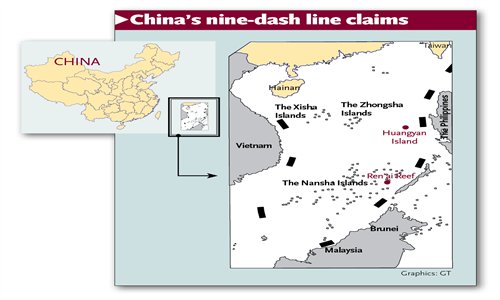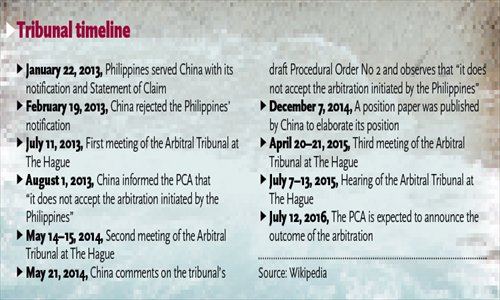HOME >> CHINA
What you need to know about The Hague arbitration, the China-Philippines sea dispute
Source:Global Times Published: 2016/7/11 21:33:00
The Permanent Court of Arbitration, an international organization based in The Hague, the Netherlands, is set to release on Tuesday its award in the Philippines-initiated case involving territory in the South China Sea which both Manila and Beijing claim. China repeatedly denied the legitimacy of the case, which was filed unilaterally by the Philippines, and has said it would not participate in or accept the result of the case.

Permanent organization
The Permanent Court of Arbitration (PCA) is an intergovernmental organization that was established in 1899 by the first Hague Peace Conference in The Hague, Netherlands. It is the oldest international conflict resolution organization in the world.
The PCA is a permanent organization and holds temporary tribunals to resolve disputes among states, intergovernmental organizations or private parties.
According to the PCA website, the International Bureau maintains both a list of PCA Members of the Court who are nominated by PCA Member States and are available to act as arbitrators in PCA-administered proceedings, as well as specialized panels of arbitrators and experts for environmental disputes and space-related disputes. However, the Secretary-General and parties in PCA proceedings are not obliged to select arbitrators from this list and are free to exercise their discretion in selecting the individuals best suited to the case at hand.
Apart from the South China Sea dispute, the PCA has mediated in two other cases concerning China, according to its official website. The first one, in which the Radio Corporation of America accused China of violating an agreement with it by entering into a similar agreement with another radio company, the PCA held in 1935 that China was not in violation of the terms of agreement as it was not exclusive. Another case, which involves three Chinese companies and the Mongolian government, is still ongoing.
Five arbitrators sat on the arbitral tribunal on the South China Sea, Judge Thomas A. Mensah, Judge Jean-Pierre Cot, Judge Stanislaw Pawlak, Professor Alfred H. Soons and Judge Rüdiger Wolfrum. Judge Rüdiger Wolfrum was appointed by the Philippines, and the other four were appointed by the then president of the International Tribunal for the Law of the Sea Shunji Yanai because China did not agree to the arbitration.

Illegitimate arbitration
The crux of the China-Philippines dispute in the South China Sea is the Philippines' occupation of islands and reefs in the Nansha Islands archipelago which China regards as its own, a state of affairs which China argues is in violation of the UN Charter and the basic norms governing international relations. With the evolution of the new regime of the law of the sea, maritime delimitation disputes have also arisen.
On January 22, 2013, the Republic of the Philippines instituted arbitral proceedings against the People's Republic of China under Annex VII to the United Nations Convention on the Law of the Sea (UNCLOS) "with respect to the dispute with China over the maritime jurisdiction of the Philippines in the West Philippine Sea." Philippine president Benigno Aquino III signed an administrative order renaming the South China Sea the "West Philippine Sea" in September 2012.
An article published by the US-based Center for Strategic and International Studies wrote that the Philippines "is seeking a ruling that declares that claims in the South China Sea must comport with UNCLOS, which would invalidate China's nine-dash line; classify maritime features occupied by China as rocks, low tide elevations, or submerged banks, but not islands; and declare the Philippines' right to operate inside of its EEZ (exclusive economic zone) and continental shelf as outlined by UNCLOS without Chinese harassment."
On February 19, 2013, China presented a document to the Philippines in which it described "the position of China on the South China Sea issues," rejected the arbitration and called on the Philippines to resolve the dispute through bilateral negotiations. China argues that the Arbitral Tribunal lacks jurisdiction in the case.
Experts have commentated that, by unilaterally initiating the arbitration on January 22, 2013, the Philippines violated agreements with China including a pledge to resolve disputes through negotiations and consultations. It also violated the provisions of UNCLOS, abused its dispute settlement procedures and infringed upon China's right under UNCLOS to independently choose dispute settlement mechanisms and procedures. The Philippine's unilateral initiation of the arbitration is thus illegal and null and void according to China. Furthermore, these submissions are related to more complicated territorial sovereignty issues, over which the court has no jurisdiction.
"Strictly speaking, the arbitration by PCA must be established on the basis that both sides of the conflict agree to take it to the court, and China refused to take it to the PCA. So speaking from principles, the arbitration should never have happened," Tao Duanfang, an independent commentator, wrote in a piece published on Baidu's online opinion platform Baijia.
In February, the US and the EU told China it should respect the ruling.
The court has no powers of enforcement and its rulings have been ignored before.

Joint exploitation
China maintains its sovereignty over the reefs and islands based on its historical claims, which it argues are backed up by abundant historical documents. The Philippines' denial of these historical arguments is founded on claims based on proximity.
The U-shaped, nine-dash line encircling most of the South China Sea is the core of China's claim. It was first published on a map drawn by the Kuomintang's Republic of China government in 1947 and then inherited by the People's Republic of China in 1949.
China's sovereignty over the South China Sea was never officially disputed until the 1960s. The Chinese people have engaged in fishing, patrolling and other activities on the islands and reefs since ancient times, until Japanese troops took control of the islands during their invasion of China in WWII. They were then returned to China after the end of the war by the "Cairo Declaration" and the "Proclamation Defining Terms for Japanese Surrender" issued in Potsdam in July 1945. For decades after then, no country questioned China's rights in the area, as part of the post-war order. The US always recognized China's sovereignty over the South China Sea islands, as seen from its official maps and activities such as informing the Chinese government prior to flybys near the islands.
The territory of the Philippines did not include the Nansha Islands or Huangyan Island according to various territory treaties signed by the US from 1898 to 1930.
It all started in the late 1960s when massive reserves of oil and natural gas were discovered in the South China Sea. After then, the Philippines and several other countries bordering the South China Sea began encroaching upon the reefs and islands. Some, including the Philippines, claimed islands for their own, completely ignoring China's sovereignty.
China hasn't been a perpetrator in this matter, but a victim, wrote Guo Jiping, a political commentator. In the face of the situation, China has maintained patience and refrained from escalating the conflict. China was the first country to propose the "joint exploitation" of the South China Sea. China has insisted on using peaceful means like negotiations to resolve disputes.
However, a Philippine naval ship harassed Chinese fishing boats near Huangyan Island and tried to seize Chinese fishermen in April 2012, which escalated tension in the area.
The Philippine government under President Aquino in January 2013 then abandoned its promises and unilaterally filed for arbitration for the South China Sea dispute.
Newspaper headline: Behind the ruling

Chinese marine guards patrol the Nansha Islands on February 9, 2016. Photo: CFP
Permanent organization
The Permanent Court of Arbitration (PCA) is an intergovernmental organization that was established in 1899 by the first Hague Peace Conference in The Hague, Netherlands. It is the oldest international conflict resolution organization in the world.
The PCA is a permanent organization and holds temporary tribunals to resolve disputes among states, intergovernmental organizations or private parties.
According to the PCA website, the International Bureau maintains both a list of PCA Members of the Court who are nominated by PCA Member States and are available to act as arbitrators in PCA-administered proceedings, as well as specialized panels of arbitrators and experts for environmental disputes and space-related disputes. However, the Secretary-General and parties in PCA proceedings are not obliged to select arbitrators from this list and are free to exercise their discretion in selecting the individuals best suited to the case at hand.
Apart from the South China Sea dispute, the PCA has mediated in two other cases concerning China, according to its official website. The first one, in which the Radio Corporation of America accused China of violating an agreement with it by entering into a similar agreement with another radio company, the PCA held in 1935 that China was not in violation of the terms of agreement as it was not exclusive. Another case, which involves three Chinese companies and the Mongolian government, is still ongoing.
Five arbitrators sat on the arbitral tribunal on the South China Sea, Judge Thomas A. Mensah, Judge Jean-Pierre Cot, Judge Stanislaw Pawlak, Professor Alfred H. Soons and Judge Rüdiger Wolfrum. Judge Rüdiger Wolfrum was appointed by the Philippines, and the other four were appointed by the then president of the International Tribunal for the Law of the Sea Shunji Yanai because China did not agree to the arbitration.

The map of China's nine-dash line claims. Graphics: GT
Illegitimate arbitration
The crux of the China-Philippines dispute in the South China Sea is the Philippines' occupation of islands and reefs in the Nansha Islands archipelago which China regards as its own, a state of affairs which China argues is in violation of the UN Charter and the basic norms governing international relations. With the evolution of the new regime of the law of the sea, maritime delimitation disputes have also arisen.
On January 22, 2013, the Republic of the Philippines instituted arbitral proceedings against the People's Republic of China under Annex VII to the United Nations Convention on the Law of the Sea (UNCLOS) "with respect to the dispute with China over the maritime jurisdiction of the Philippines in the West Philippine Sea." Philippine president Benigno Aquino III signed an administrative order renaming the South China Sea the "West Philippine Sea" in September 2012.
An article published by the US-based Center for Strategic and International Studies wrote that the Philippines "is seeking a ruling that declares that claims in the South China Sea must comport with UNCLOS, which would invalidate China's nine-dash line; classify maritime features occupied by China as rocks, low tide elevations, or submerged banks, but not islands; and declare the Philippines' right to operate inside of its EEZ (exclusive economic zone) and continental shelf as outlined by UNCLOS without Chinese harassment."
On February 19, 2013, China presented a document to the Philippines in which it described "the position of China on the South China Sea issues," rejected the arbitration and called on the Philippines to resolve the dispute through bilateral negotiations. China argues that the Arbitral Tribunal lacks jurisdiction in the case.
Experts have commentated that, by unilaterally initiating the arbitration on January 22, 2013, the Philippines violated agreements with China including a pledge to resolve disputes through negotiations and consultations. It also violated the provisions of UNCLOS, abused its dispute settlement procedures and infringed upon China's right under UNCLOS to independently choose dispute settlement mechanisms and procedures. The Philippine's unilateral initiation of the arbitration is thus illegal and null and void according to China. Furthermore, these submissions are related to more complicated territorial sovereignty issues, over which the court has no jurisdiction.
"Strictly speaking, the arbitration by PCA must be established on the basis that both sides of the conflict agree to take it to the court, and China refused to take it to the PCA. So speaking from principles, the arbitration should never have happened," Tao Duanfang, an independent commentator, wrote in a piece published on Baidu's online opinion platform Baijia.
In February, the US and the EU told China it should respect the ruling.
The court has no powers of enforcement and its rulings have been ignored before.

Tribunal timeline. Photo: GT
Joint exploitation
China maintains its sovereignty over the reefs and islands based on its historical claims, which it argues are backed up by abundant historical documents. The Philippines' denial of these historical arguments is founded on claims based on proximity.
The U-shaped, nine-dash line encircling most of the South China Sea is the core of China's claim. It was first published on a map drawn by the Kuomintang's Republic of China government in 1947 and then inherited by the People's Republic of China in 1949.
China's sovereignty over the South China Sea was never officially disputed until the 1960s. The Chinese people have engaged in fishing, patrolling and other activities on the islands and reefs since ancient times, until Japanese troops took control of the islands during their invasion of China in WWII. They were then returned to China after the end of the war by the "Cairo Declaration" and the "Proclamation Defining Terms for Japanese Surrender" issued in Potsdam in July 1945. For decades after then, no country questioned China's rights in the area, as part of the post-war order. The US always recognized China's sovereignty over the South China Sea islands, as seen from its official maps and activities such as informing the Chinese government prior to flybys near the islands.
The territory of the Philippines did not include the Nansha Islands or Huangyan Island according to various territory treaties signed by the US from 1898 to 1930.
It all started in the late 1960s when massive reserves of oil and natural gas were discovered in the South China Sea. After then, the Philippines and several other countries bordering the South China Sea began encroaching upon the reefs and islands. Some, including the Philippines, claimed islands for their own, completely ignoring China's sovereignty.
China hasn't been a perpetrator in this matter, but a victim, wrote Guo Jiping, a political commentator. In the face of the situation, China has maintained patience and refrained from escalating the conflict. China was the first country to propose the "joint exploitation" of the South China Sea. China has insisted on using peaceful means like negotiations to resolve disputes.
However, a Philippine naval ship harassed Chinese fishing boats near Huangyan Island and tried to seize Chinese fishermen in April 2012, which escalated tension in the area.
The Philippine government under President Aquino in January 2013 then abandoned its promises and unilaterally filed for arbitration for the South China Sea dispute.
Newspaper headline: Behind the ruling
Posted in: In-Depth